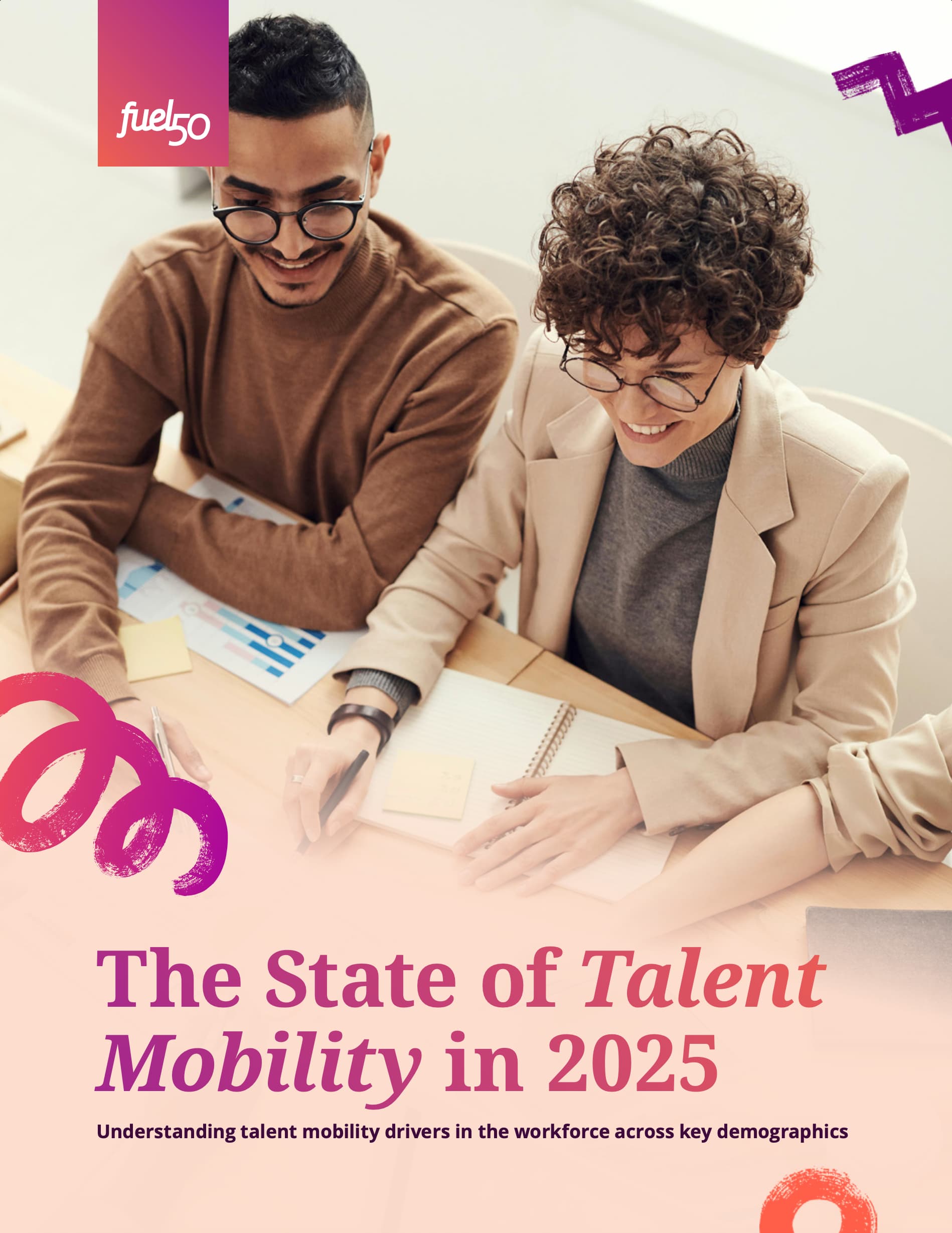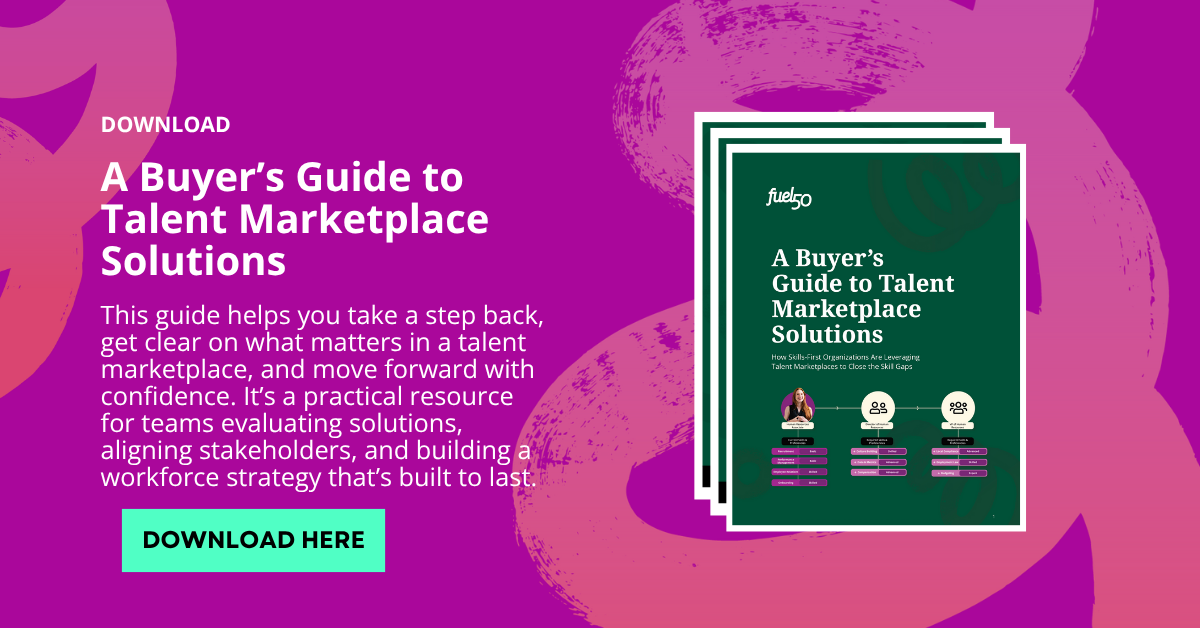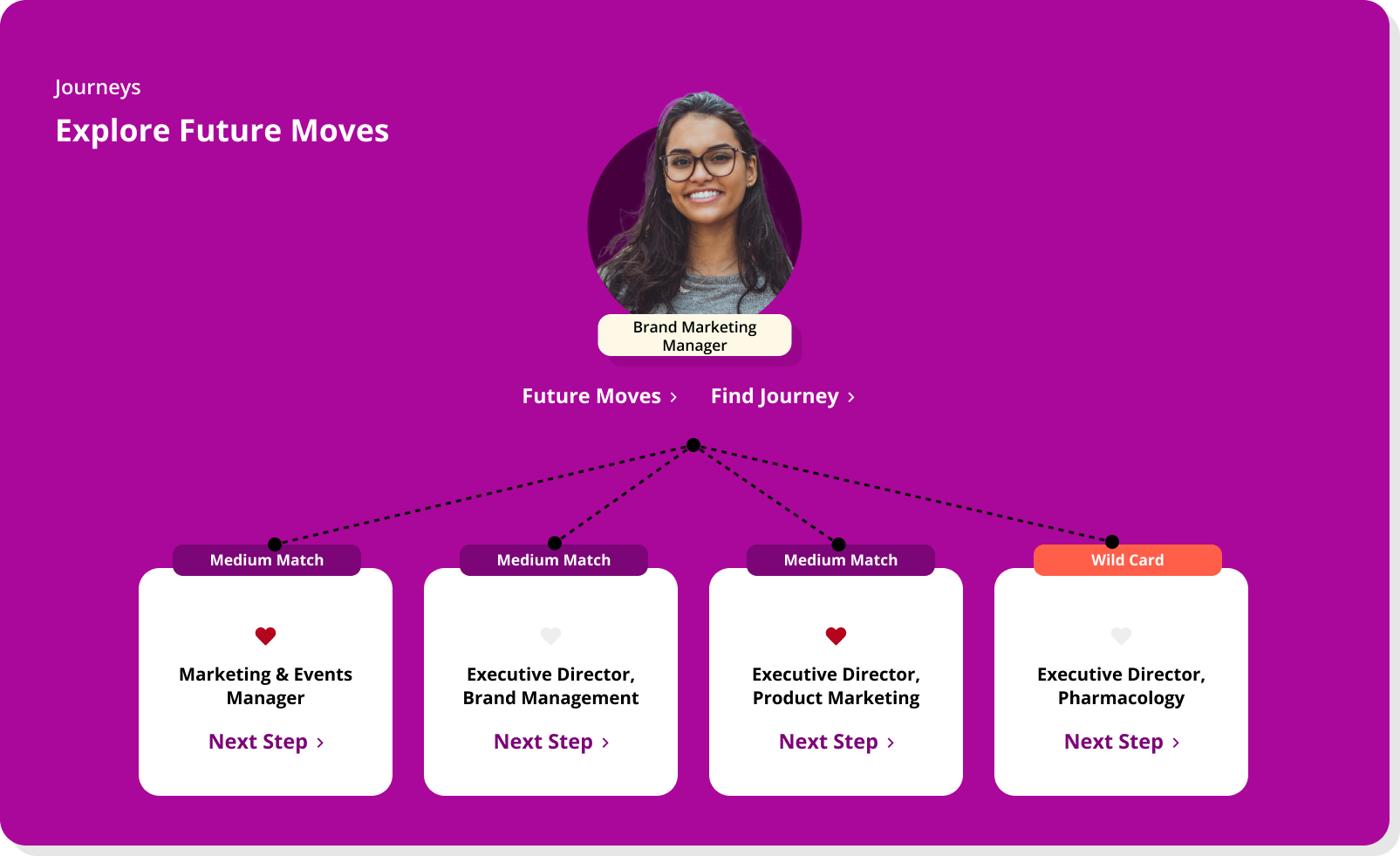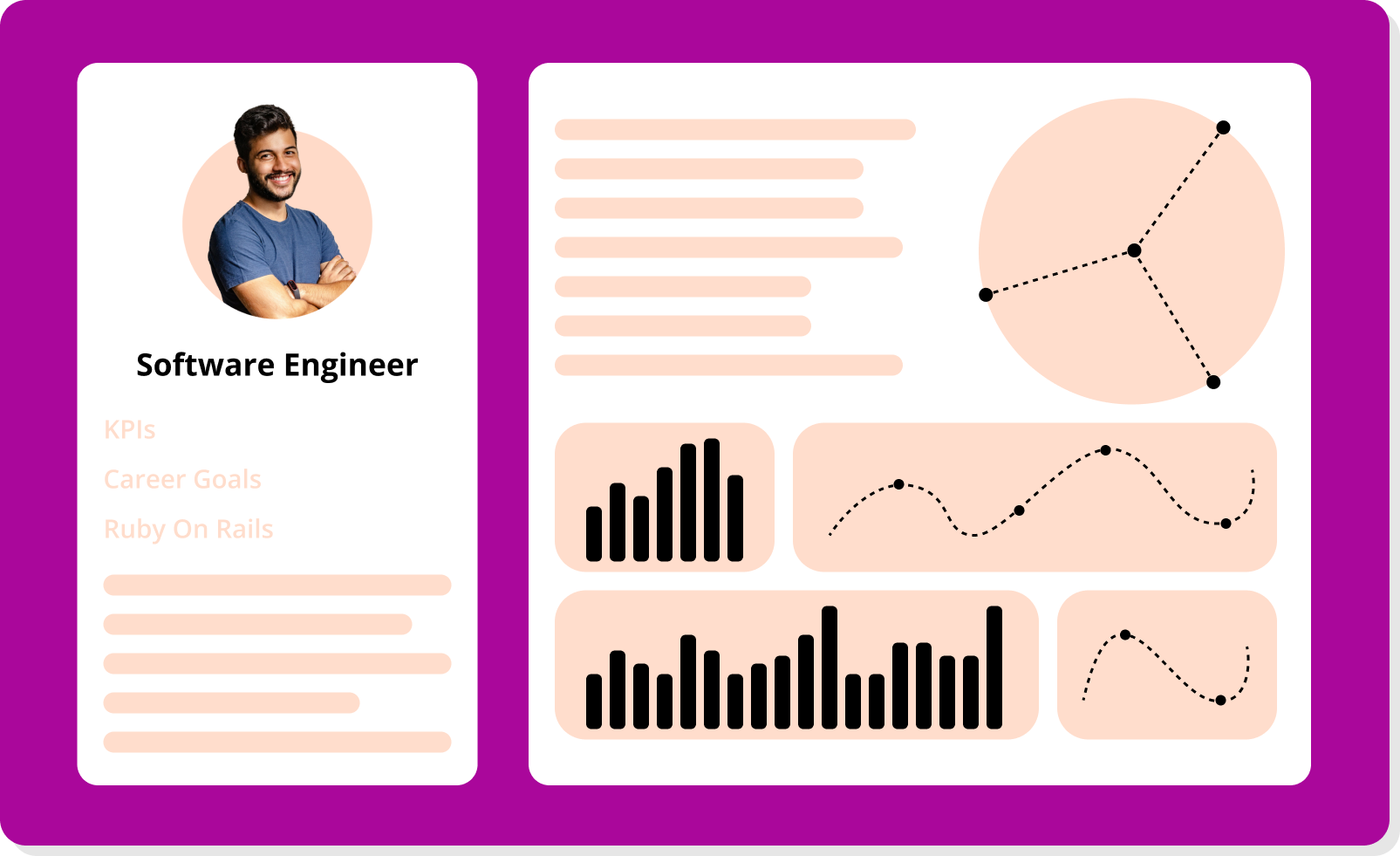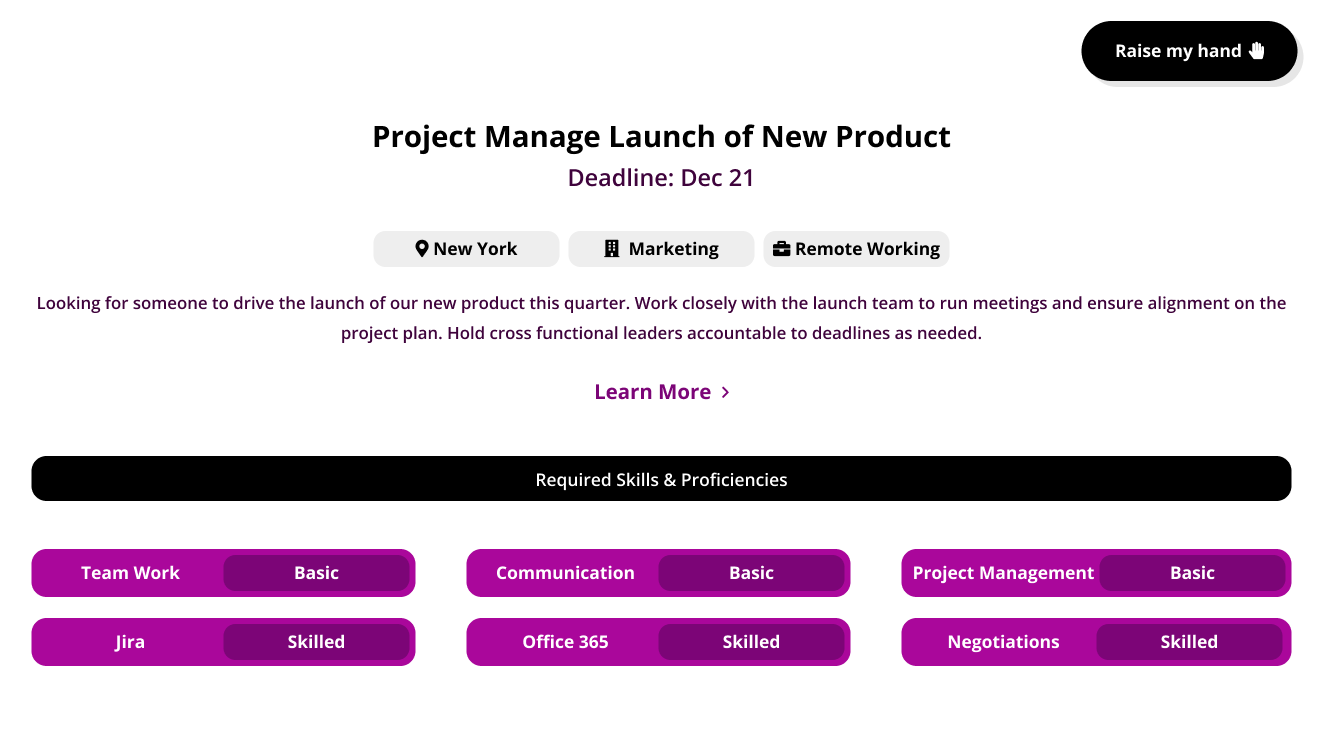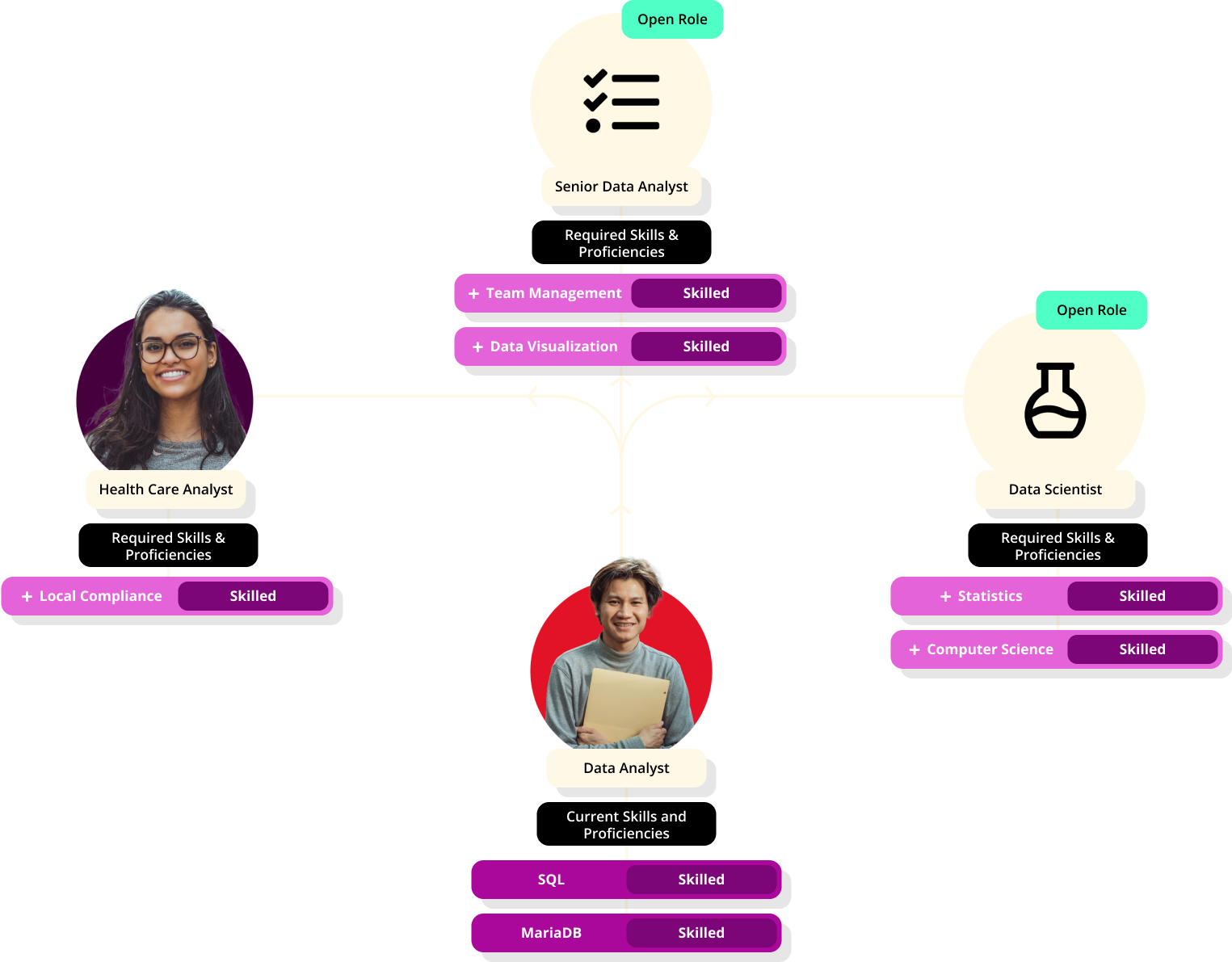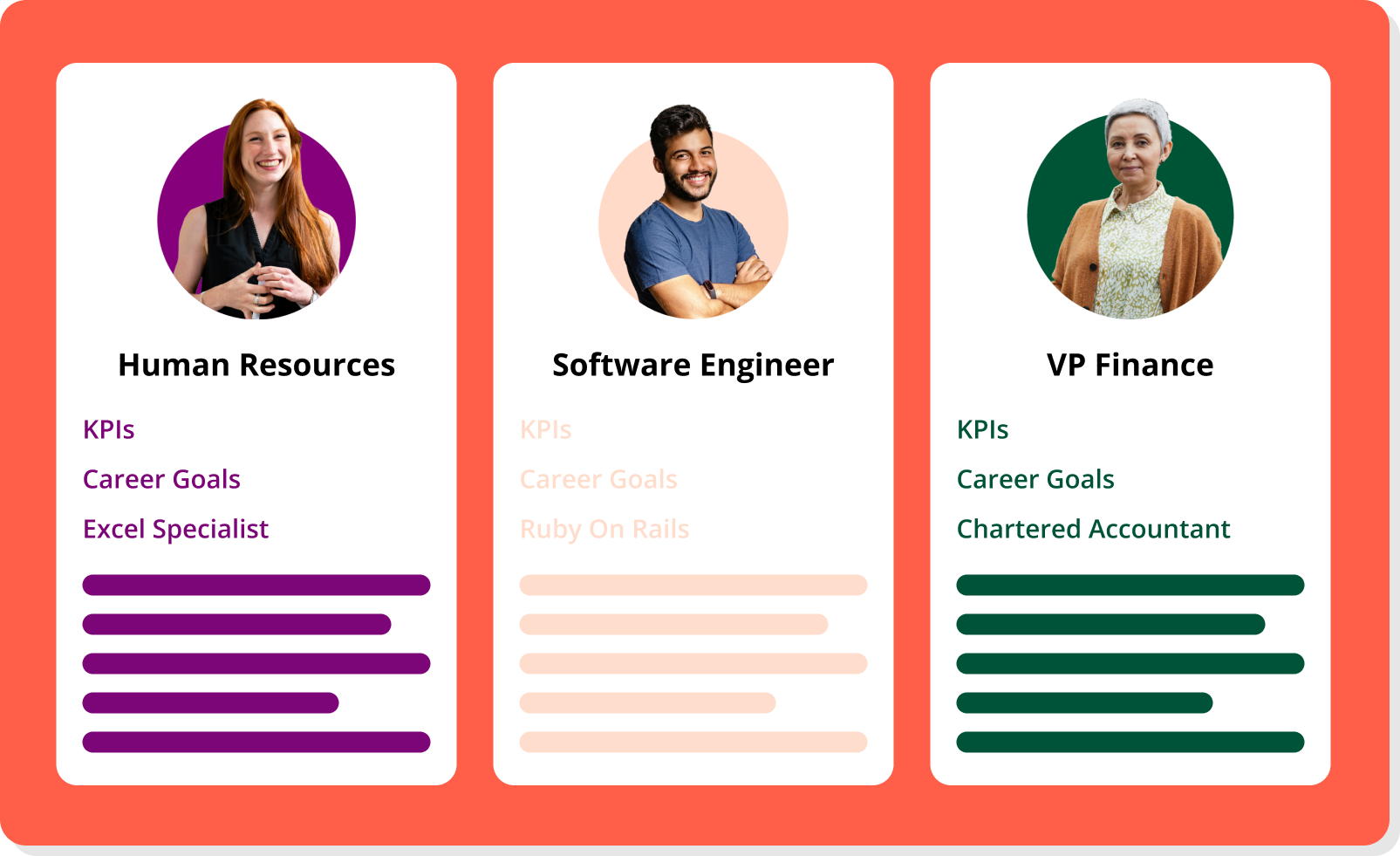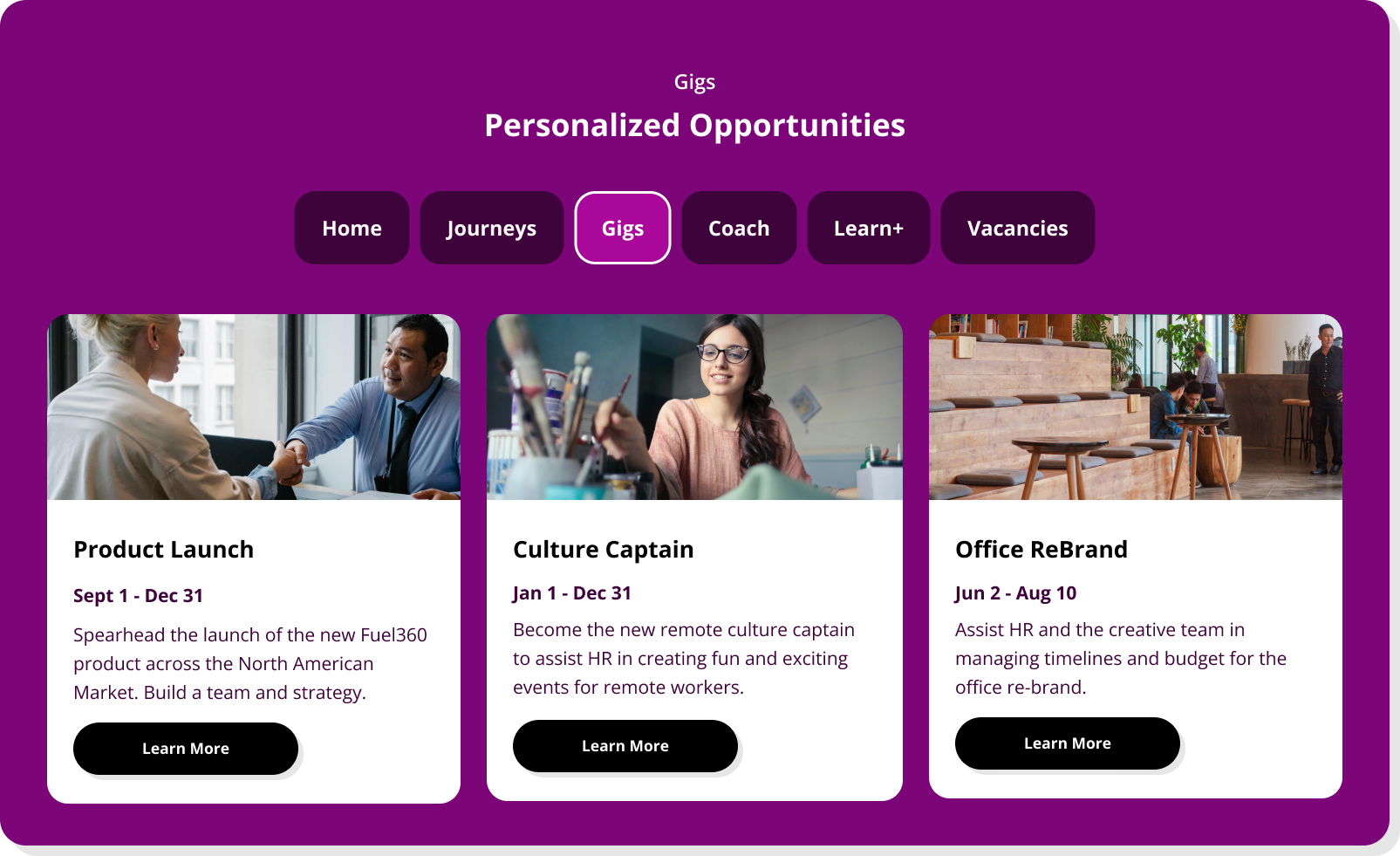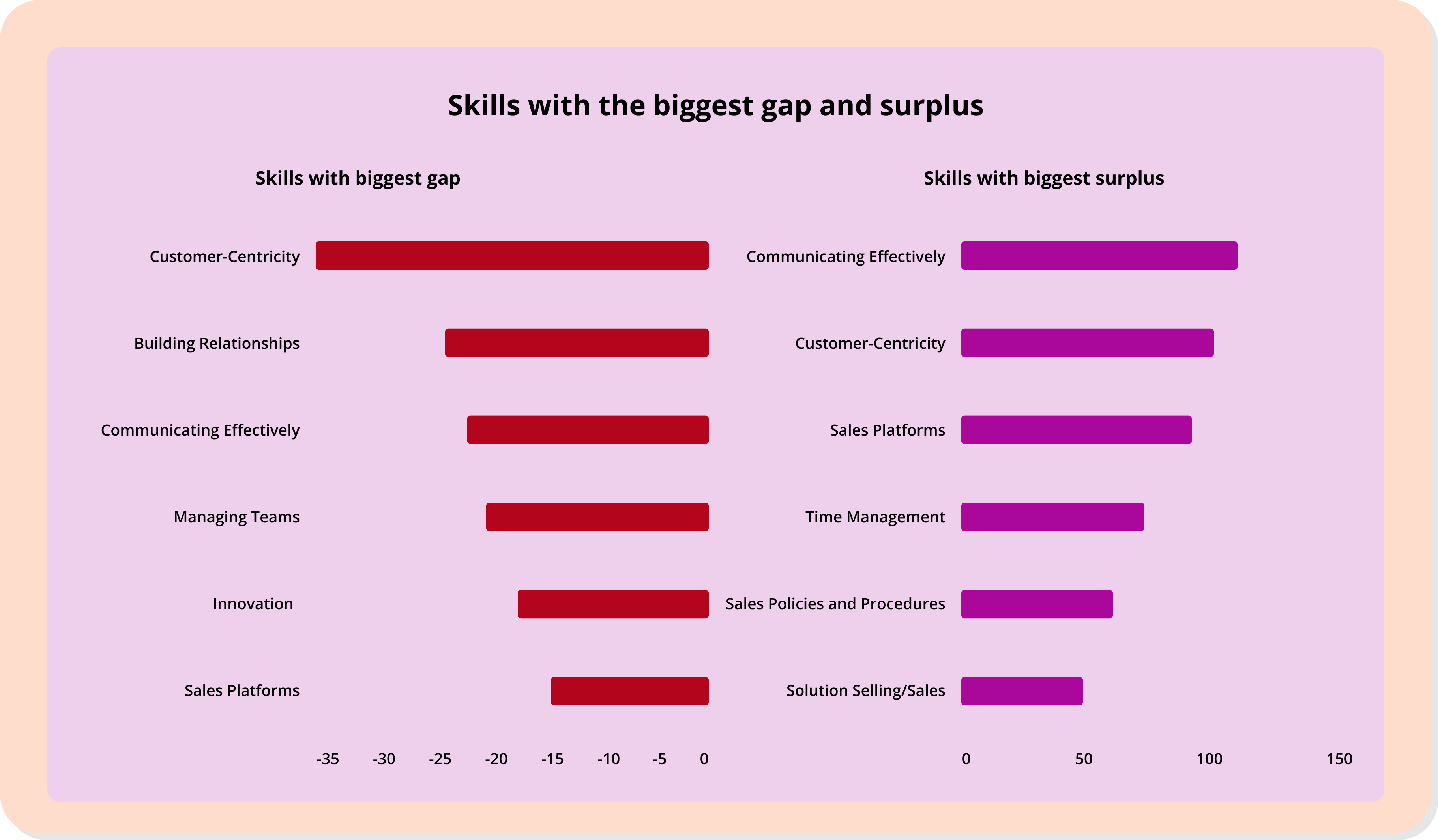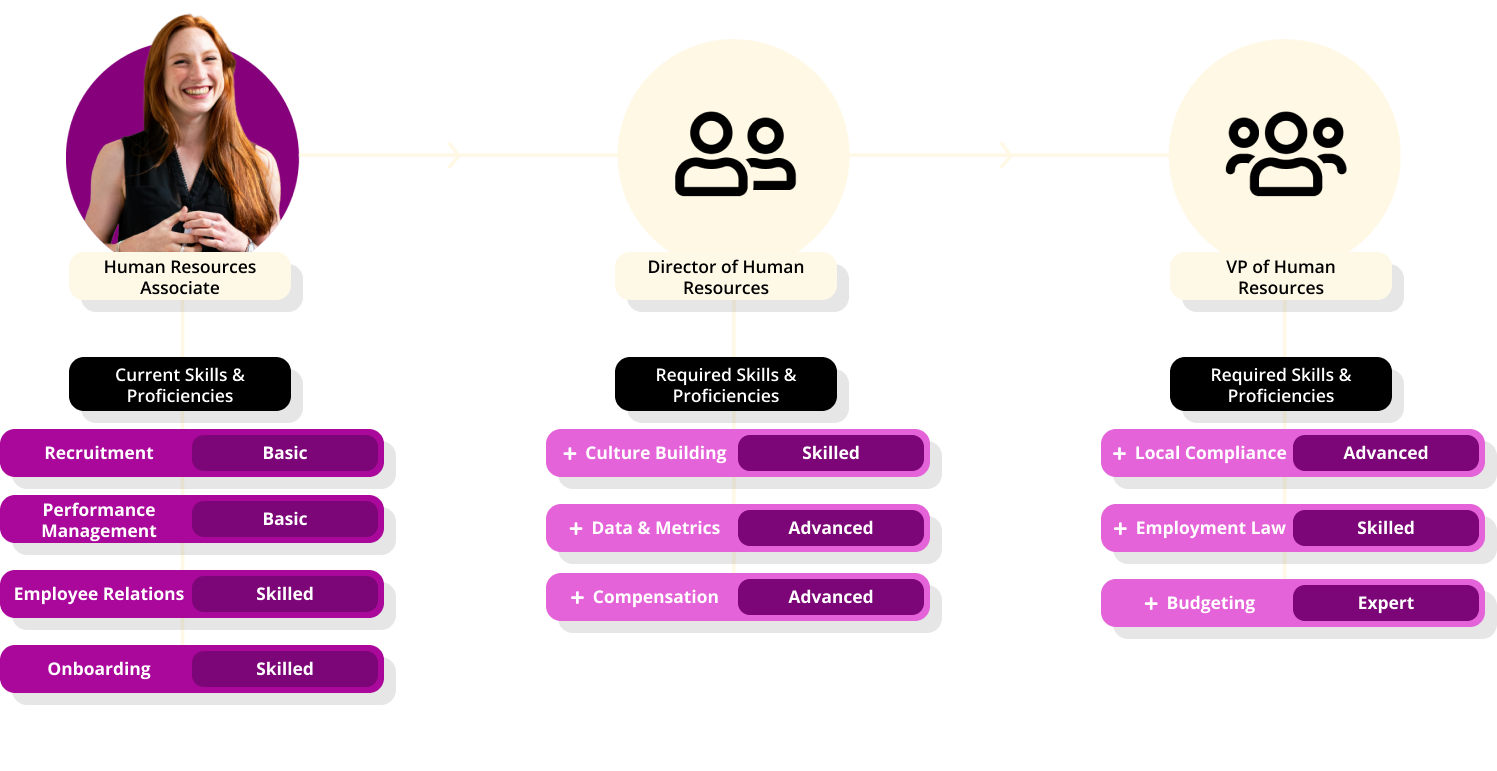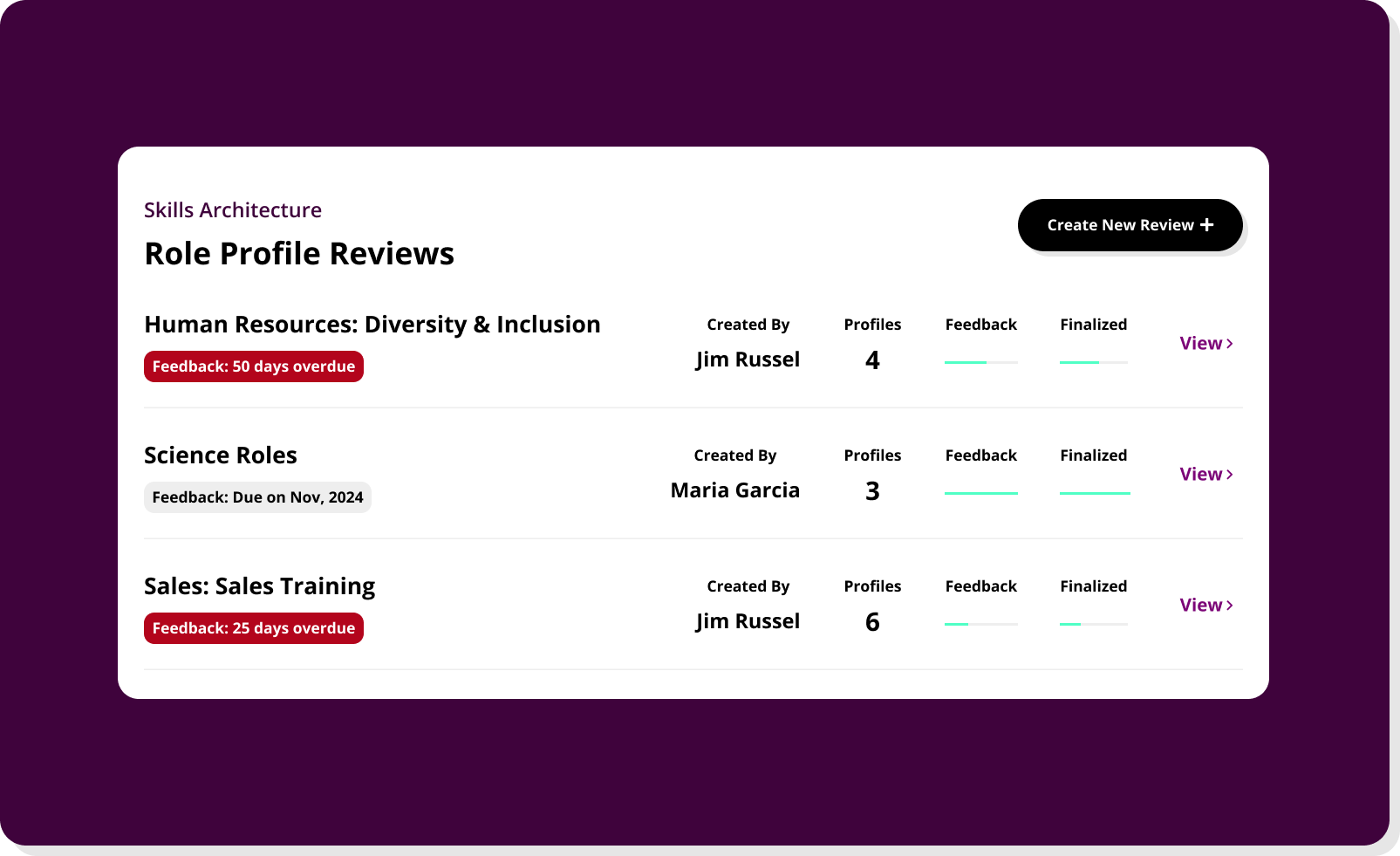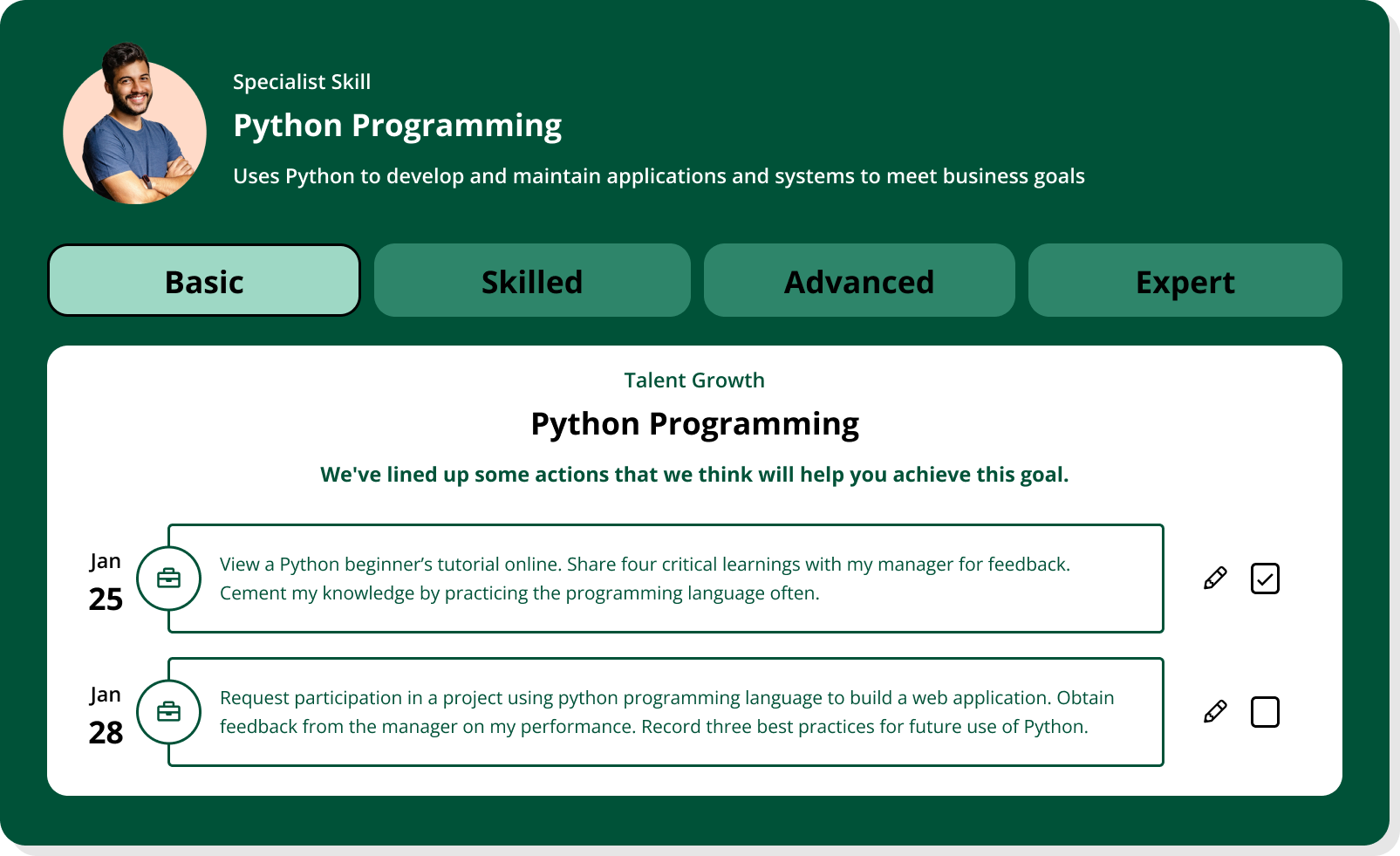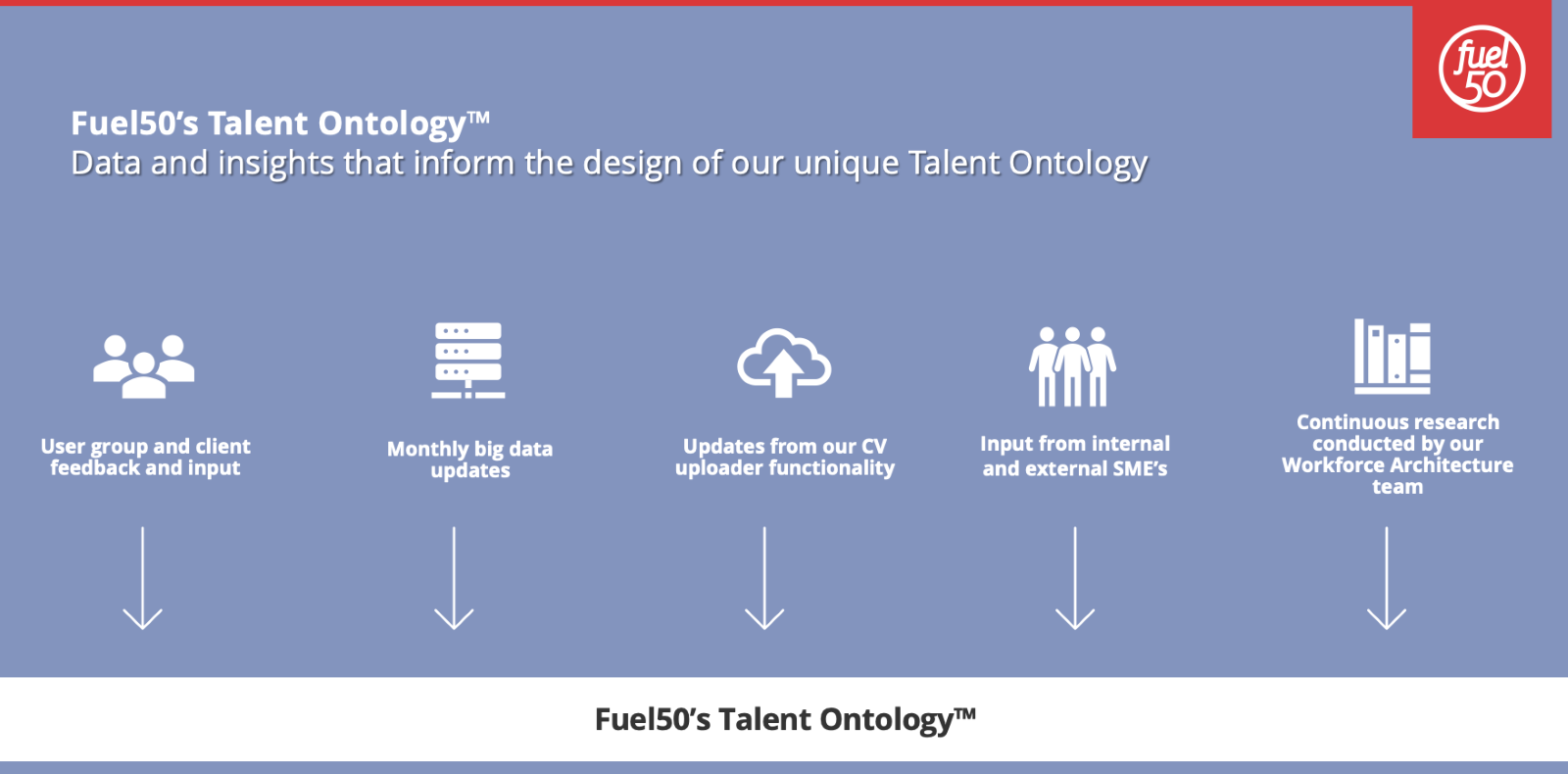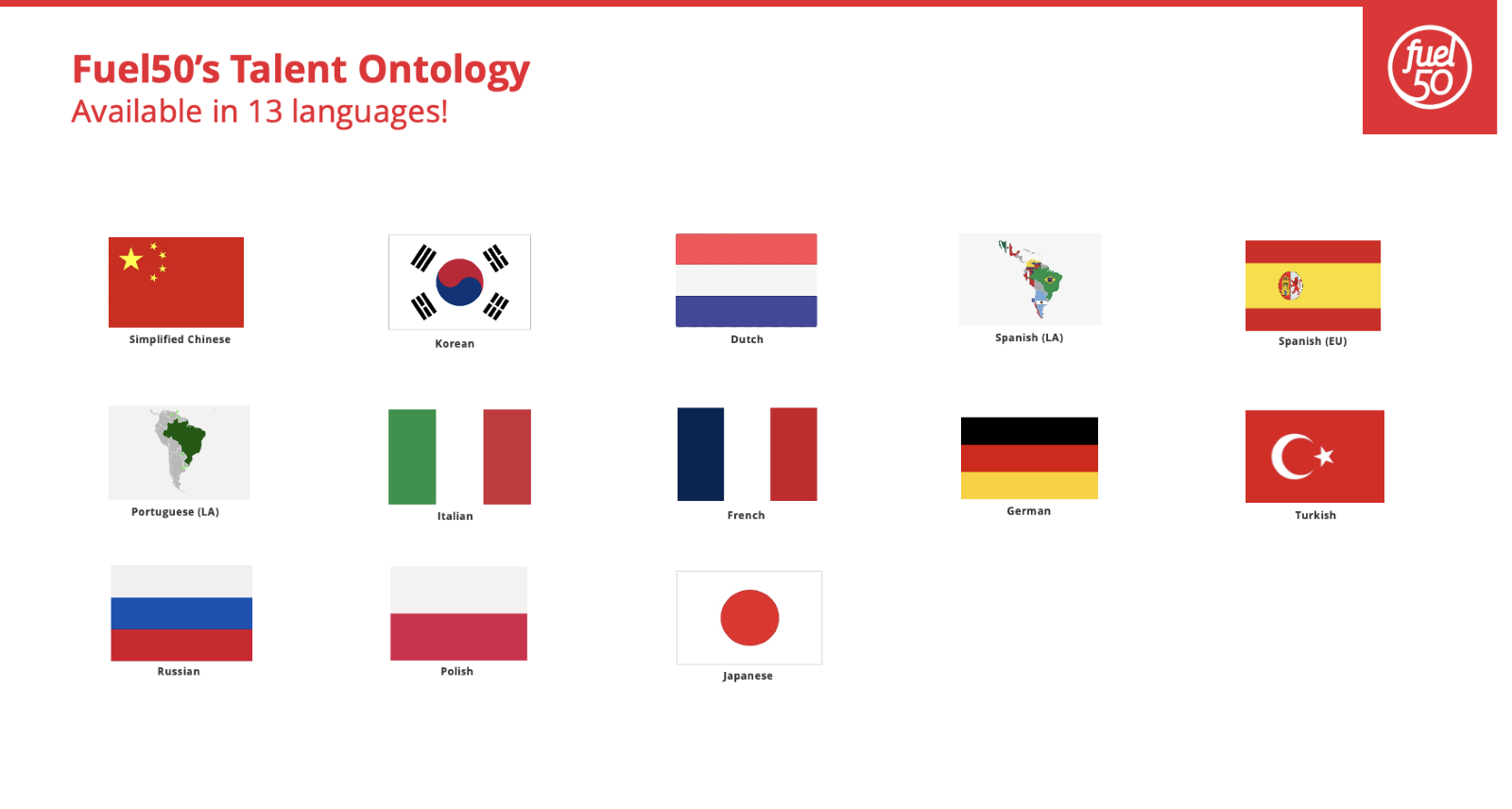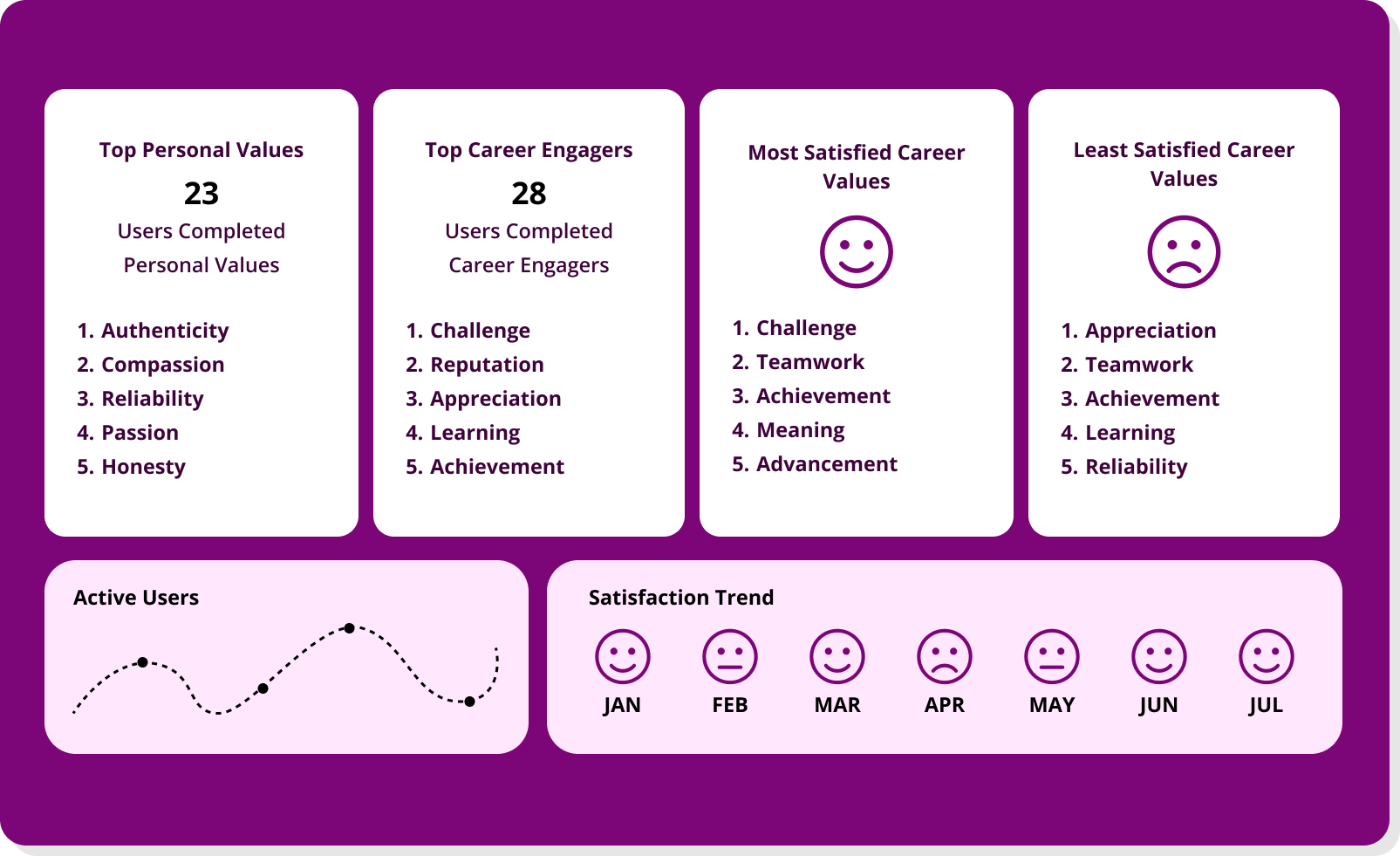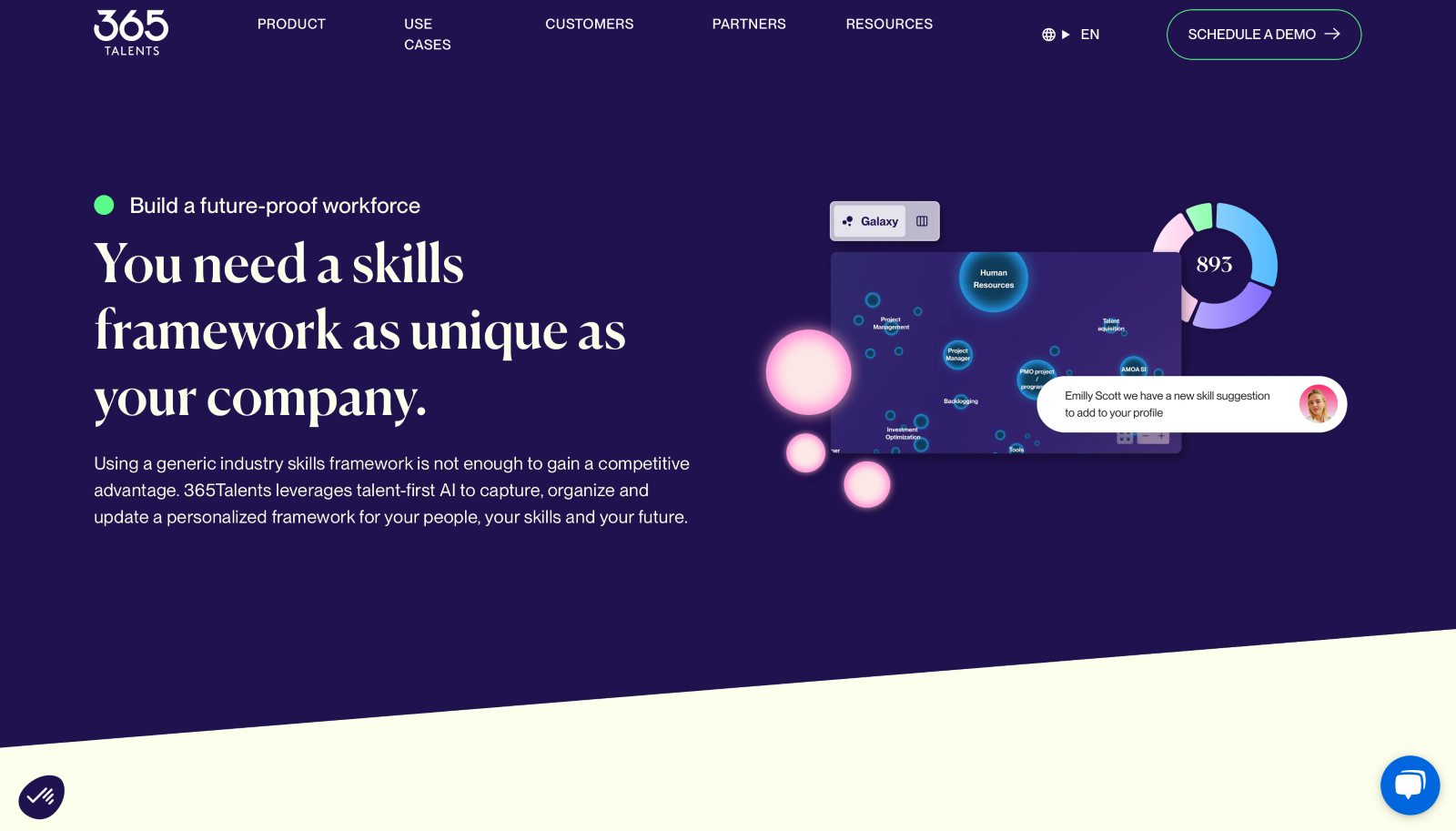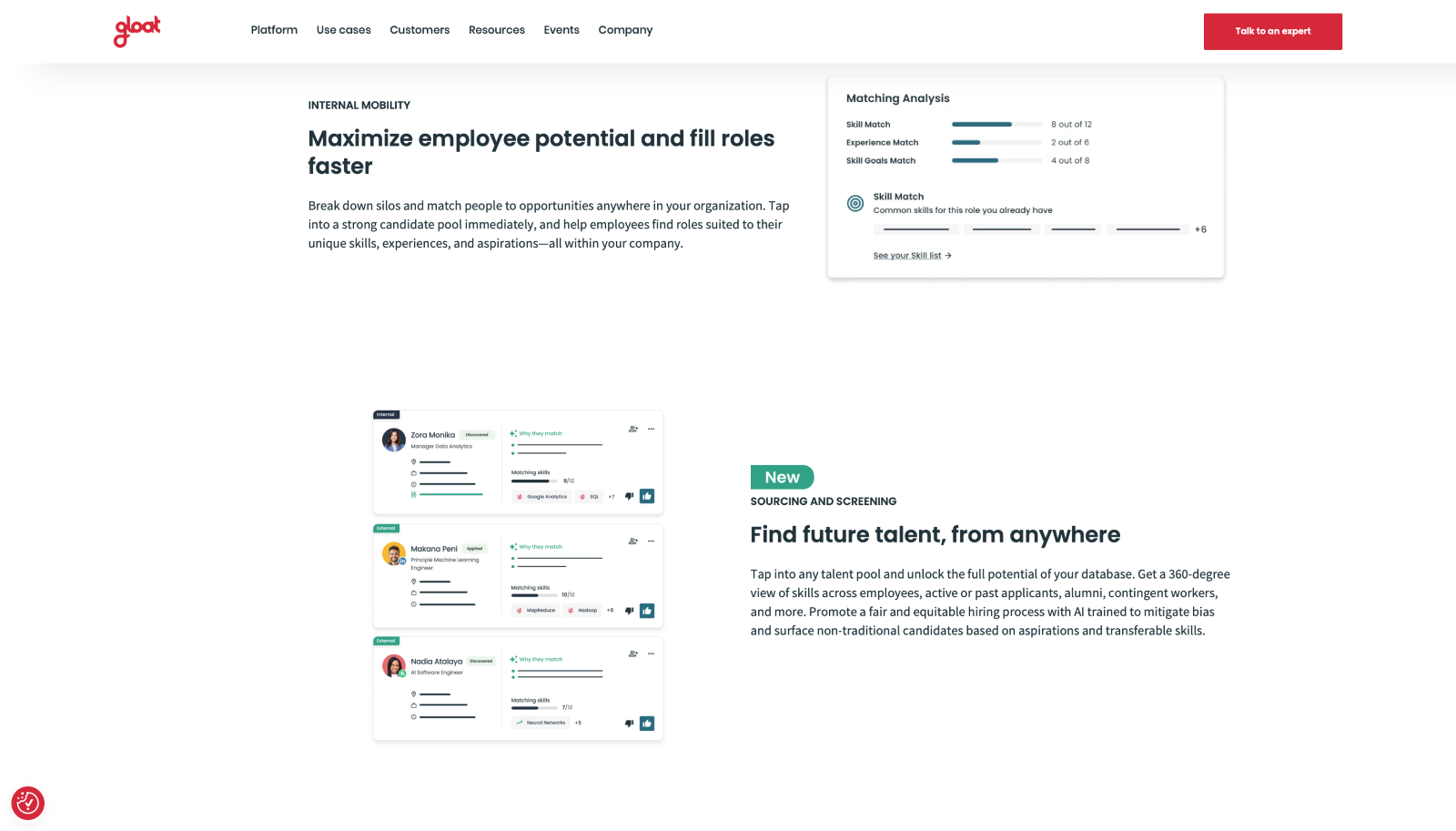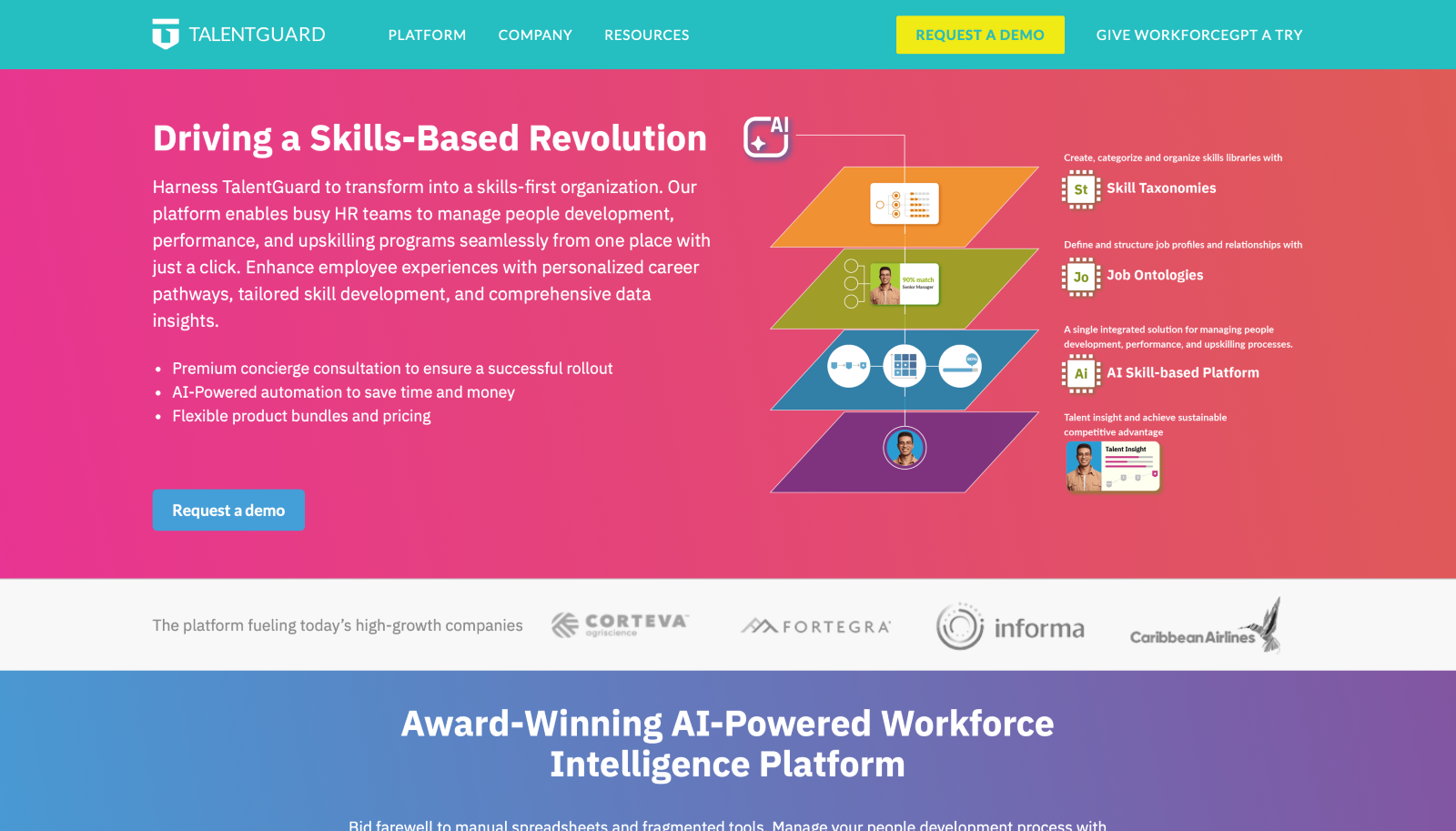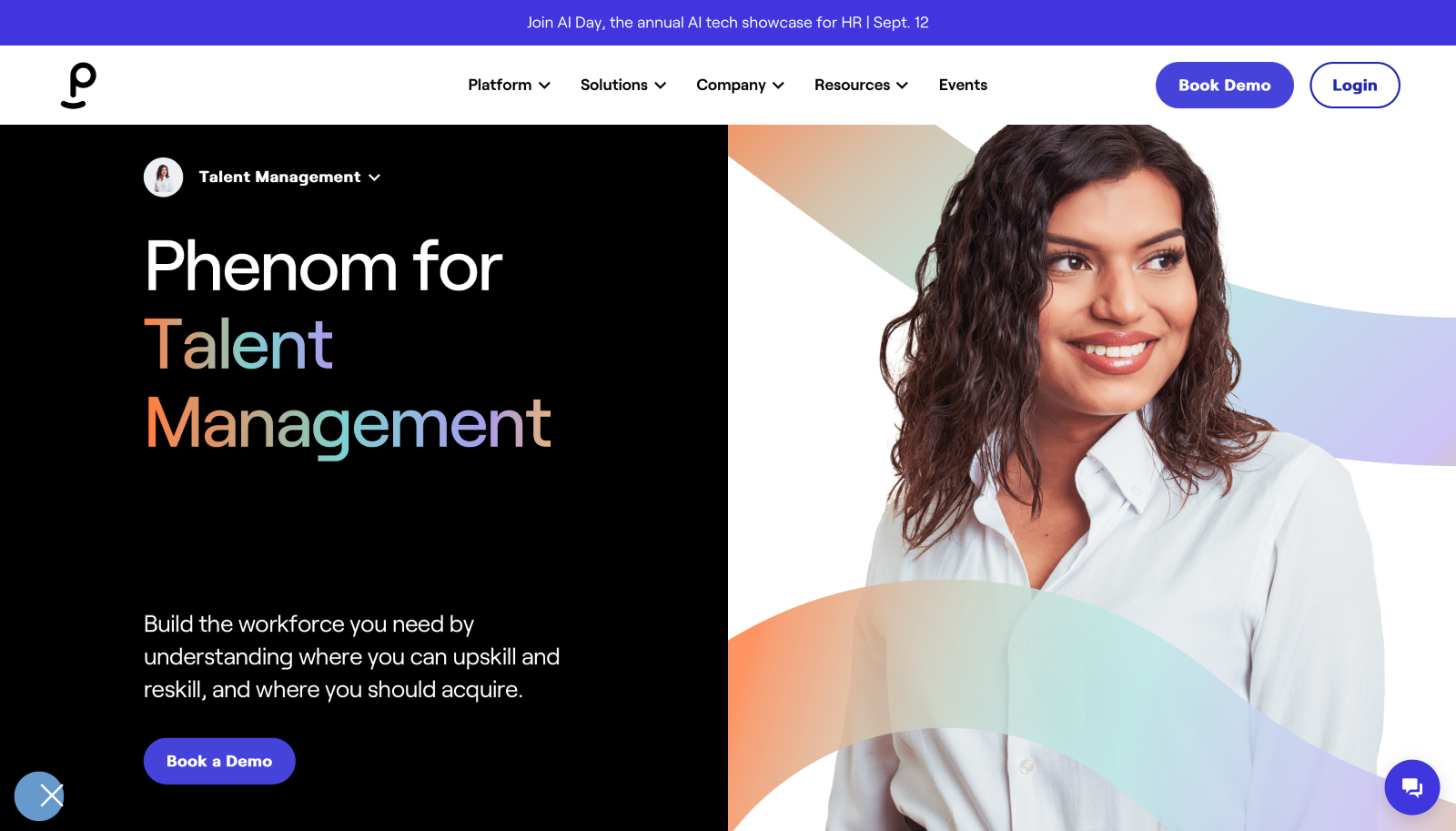Your talent is walking out the door in search of growth opportunities that might already exist within your organization. Internal talent marketplace platforms promises to solve these issues.
In this article, we’ll cut through the hype to examine 7 enterprise-grade talent marketplace solutions. We’ll look beyond flashy features to assess how each platform addresses the real challenges faced by CHROs, talent leaders, and CEOs in today’s skills-based economy.
Fuel50: The only talent intelligence platform that nurtures and serves the whole employee
At Fuel50, we’ve made it our mission to address this urgent challenge head-on. We believe that the solution lies not just in matching skills to roles but in nurturing and serving the whole employee.
What sets Fuel50 apart is our unique approach to talent intelligence.
Unlike platforms that focus solely on skill matching or career pathing, Fuel50 provides a comprehensive ecosystem that considers an employee’s skills, aspirations, potential, and personal growth.
Our platform creates a “career DNA” for each employee, ensuring that every interaction and opportunity is tailored to their unique profile. This holistic approach not only addresses immediate skill gaps but also fosters long-term employee engagement and organizational agility.
Here’s how Fuel50 can help you solve the skills crisis:
Fuel50 empowers employees’ career growth and internal mobility with a talent marketplace
Fuel50 talent marketplace offers increased workforce agility, improved retention of top talent, and the ability to quickly mobilize skills where they’re needed most.
Key differentiators include:
Hyper-personalization
The platform tailors opportunities, learning recommendations, and internal career opportunities to each individual’s evolving skills and aspirations. It analyzes an employee’s current skills, past experiences, and future goals to create a unique profile.
This profile is then used to match people with relevant job openings, gig work, mentorship opportunities, and learning resources.
As employees interact with the platform, their profile becomes more refined, leading to increasingly accurate recommendations.
Imagine being able to fill critical project needs in days rather than months, all while boosting employee satisfaction and development.
Advanced AI career journeys
Fuel50 maps out multiple career paths, including non-traditional moves, fostering internal mobility and retention. The system doesn’t just show linear progressions but identifies potential lateral moves and cross-functional opportunities.
It provides step-by-step guidance on how to move from one role to another, including the skills to acquire and experiences to gain. This feature helps employees visualize their future within the entire organization, reducing the likelihood of them seeking opportunities elsewhere.
This approach helps eliminate bias in career progression. Unlike traditional methods where promotions might be influenced by who you know or subjective opinions, Fuel50’s system focuses on skills, experiences, and potential.
That means everyone gets a fair shot at advancing, regardless of their background or who they grab coffee with. It’s leveling the playing field in a way that’s pretty revolutionary for internal mobility.
This whole setup helps employees see a future for themselves within the organization. And when people can visualize their growth path, they’re less likely to start browsing LinkedIn for new opportunities.
Integrated AI architecture
The system connects various HR data points, providing a holistic view of the organization’s talent landscape. It integrates with existing HRIS, LMS, and performance management systems to create a comprehensive talent profile for each employee.
This integration allows for real-time updates to employee skills and experiences, ensuring that the internal talent marketplace always reflects the most current information.
The AI also analyzes organizational data to identify skill gaps, predict future talent needs, and suggest strategic workforce planning initiatives.
Build a future-proof workforce framework using our skills architecture
Our Skills Architecture solution revolutionizes how enterprises structure their workforce. By automating the design of roles, functions, and levels, it allows organizations to adapt quickly to market changes.
This means you can restructure your workforce in real-time, aligning skills with emerging business needs. It’s like having a flexible, living organizational chart that evolves with your business strategy.
Create a common language for skills with our skills ontology tool
With over 5,000 unique capabilities, specialist skills, and tools, it provides a rich, multidimensional view of workforce competencies that’s unmatched in the industry.
Unlike traditional skills taxonomies that often include only 350-400 skills and remain static, Fuel50’s Skills Ontology is a living system. It also includes clear definitions and proficiency levels, which others don’t.
It continuously evolves based on market trends, emerging technologies, and changing business needs. This evolution is driven by a combination of AI-powered data analysis and human expertise from Fuel50’s team of I/O Psychologists and Workforce Architects.
The ontology’s structure is three-dimensional, defining relationships between skills and creating a sophisticated skills ecosystem. This approach allows organizations to understand not just what skills they have, but how those skills interconnect and can be applied across different roles and functions.
A key differentiator of Fuel50’s Skills Ontology is its deep integration of Diversity, Equity, and Inclusion (DEI) principles.
The system is designed with built-in bias mitigation, ensuring that skill definitions and relationships don’t perpetuate historical biases. This focus extends to incorporating critical DEI capabilities in executive and manager-level roles, supporting a top-down shift in organizational culture.
Each skill in the ontology comes with detailed proficiency level descriptions and development actions, providing clear pathways for employee growth. The system also includes capability clusters for emerging areas like cybersecurity, digital transformation, and post-pandemic capabilities, allowing organizations to quickly adapt to new business challenges.
Fuel50’s Skills Ontology is available in 13 languages, making it a truly global solution for multinational enterprises.
This multilingual capability ensures consistency in skills mapping and talent management across diverse, global workforces.
Make data-driven talent decisions with Fuel50 Insights
Fuel50 Insights transforms raw data into actionable intelligence. It provides a panoramic view of your talent landscape, allowing HR leaders to make informed decisions about skill development, succession planning, and workforce strategy.
For enterprises, this means the ability to predict future skill needs, identify high-potential employees, and optimize learning and development investments using competency management software solutions. It’s like having a crystal ball for your workforce planning.
Top 6 talent marketplace software solutions that’ll help you build a skills-based organization
We scouted Google, G2, and Gartner, and here are some of the most loved talent marketplace software for enterprise brands.
GoFigr
- AI-driven internal talent marketplace platform
- Suitable for companies of all sizes
- Focuses on internal mobility and gig work models
- Offers features for skill mapping, career pathing, and opportunity matching
- Integrates with various HR systems
GoFIGR, previously known as Flow of Work, positions itself as an internal talent marketplace platform designed to optimize internal mobility and talent retention strategies.
The FIGR in their name stands for Find, Inspire, Grow, and Retain, reflecting their mission to unlock the full potential of teams and build the workforce of tomorrow.
The platform leverages AI-driven technologies to collect and analyze employee skill sets, predict potential career pathways, and align these with business needs.
GoFIGR emphasizes an easy-to-use and straightforward experience, aiming to minimize the learning curve for both HR teams and employees.
Key features of GoFIGR include:
- Talent Scout, which brings visibility into employee skills and experience for efficient internal recruitment and project staffing.
- Career Path Finder, which leverages AI to help employees create potential career paths within the organization.
- Opportunity Marketplace, which matches employees with internal gigs.
- Talent Insights, which provides analytics dashboards for workforce skills and development needs.
- Coaching Tool, which enables career conversations and goal setting using behavioral science principles.
GoFIGR can integrate with most HRIS, ATS, LMS, performance management, payroll, reward and recognition systems, and intranets, aiming to ensure a seamless flow of information and efficient talent management.
Strengths:
- Comprehensive AI-driven approach: GoFIGR uses advanced artificial intelligence technologies to analyze skills, predict new career paths, and match employees with opportunities.
- Versatility: The platform is suitable for companies of all sizes, making it adaptable to various organizational needs.
- Focus on internal mobility: GoFIGR specifically targets internal talent utilization and retention, which can help reduce hiring costs and improve employee engagement.
- Wide integration capabilities: The platform can integrate with a variety of HR systems, potentially allowing for seamless incorporation into existing tech stacks.
- User-friendly interface: GoFIGR emphasizes an easy-to-use experience, which could lead to better adoption rates among employees and HR teams.
Limitations:
- Relatively new player: As a rebranded company (previously Flow of Work), GoFIGR may have a less established market presence compared to some competitors.
- Potential over-reliance on AI: While artificial intelligence powered features are a strength, some organizations might prefer more human-controlled processes in talent management.
- Limited track record: Without specific case studies or long-term success stories provided, it’s difficult to assess the platform’s effectiveness in various scenarios.
- Possible feature overlap: In organizations with existing HR tools, some of GoFIGR’s features might duplicate functionalities, potentially leading to economic loss.
365Talents
- AI-powered skills management platform with a focus on European markets
- Offers a unique “Skills DNA” feature for precise skill mapping
- Provides multilingual support for global enterprises
- Integrates with major HR systems like Workday and SAP SuccessFactors
- Emphasizes internal mobility and project-based work allocation
365Talents has carved out a niche in the talent marketplace space, particularly in Europe, since its founding in 2015.
While not as widely known in North America as some competitors like Gloat or Fuel50, 365Talents offers enterprise-grade features that warrant consideration for global organizations.
The platform’s “Skills DNA” technology stands out in the crowded field of AI-driven skill mapping. Unlike some competitors that rely heavily on self-reported skills, 365Talents takes a more holistic approach, analyzing various data sources to create comprehensive skill profiles.
This approach may provide a more accurate picture of an organization’s skill inventory, especially for large enterprises where self-reporting can be inconsistent.
365Talents’ multilingual capabilities set it apart from many US-centric platforms. For multinational corporations dealing with workforce management across multiple countries and languages, this feature could be a significant advantage over competitors like GoFigr or TalentGuard, which may have more limited language support.
However, 365Talents faces stiff competition in the enterprise market. While it integrates with major HR systems, companies like Fuel50, Phenom, and Eightfold.ai often boast more extensive integration ecosystems.
Additionally, although 365Talents offers internal mobility features, it may not be as robust in this area as Fuel50, which has made career pathing a cornerstone of its platform.
The platform’s focus on project-based work allocation aligns well with the growing trend of internal gig economies in large enterprises. This feature puts it on par with Gloat in terms of supporting more flexible work arrangements, which could be attractive to organizations looking to improve resource allocation and employee engagement.
For enterprises considering 365Talents, it’s crucial to evaluate how its European-centric approach aligns with their global talent strategy. While its multilingual capabilities are a strength, organizations primarily focused on North American markets might find platforms with stronger presence in that region, like Fuel50 or Gloat, to be a better fit.
Strengths:
- Strong presence in European markets with multilingual capabilities
- Advanced AI-driven skills mapping through “Skills DNA” technology
- Robust support for internal mobility and project-based work
- Integration with major HR systems enhances its appeal to large enterprises
Limitations:
- Less established presence in North American markets compared to European ones
- May require more customization for industries with highly specialized skill sets
- Some users report a steeper learning curve compared to other platforms
Gloat
Key information:
- Pioneer in AI-powered internal talent marketplaces
- Offers a dynamic skills ontology that evolves with market trends
- Provides robust workforce analytics and planning tools
- Supports both job matching and project-based opportunities
- Used by numerous Fortune 500 companies globally
Gloat has positioned itself as a leader in the talent marketplace space, offering a robust platform that goes beyond simple job matching. Its solution is designed to address the complex talent management needs of large enterprises, with a focus on creating a skills-based organization.
One of Gloat’s standout features is its dynamic skills ontology. This AI-driven system continuously evolves based on market trends and organizational data, allowing for more accurate skill mapping and matching. For large companies navigating rapid industry shifts, this adaptability is crucial in maintaining an agile workforce.
Gloat’s platform is notably comprehensive, offering tools for internal mobility, project-based work, career pathing, and even mentorship and networking. This all-in-one approach sets it apart from more specialized competitors.
For instance, while some platforms focus solely on job matching or career development, Gloat attempts to cover the entire spectrum of talent management needs.
The platform’s “Career Navigator” feature empowers employees by providing clarity on how their skills align with various roles and what skills they need to develop for future positions.
This self-service approach to career development can be particularly appealing for large organizations looking to foster a culture of continuous learning and growth.
Gloat also offers robust analytics and planning tools, including a “Succession Discovery” feature. This allows organizations to identify and prepare candidates for critical roles, addressing a key concern for many enterprises struggling with succession planning.
However, the comprehensiveness of Gloat’s offering may be a double-edged sword. While it provides a wide range of features, some users report a steep learning curve. This could potentially slow down adoption rates across large workforces or prove overwhelming for organizations just beginning their talent marketplace journey.
Strengths:
- Proven track record with Fortune 500 companies
- Dynamic skills ontology that adapts to changing market needs
- Robust workforce analytics and planning capabilities
- Support for both job matching and project-based work
Limitations:
- Steeper learning curve reported by some users
- May be overly complex for smaller organizations
- Career pathing tools may not be as specialized as some competitors
- The fact they are 100% AI driven causes inconsistencies in the recommendations
Eightfold
Key information:
- AI-powered Talent Intelligence Platform
- Offers deep-learning AI for comprehensive talent insights
- Provides solutions for talent acquisition, management, and development
- Features a Project Marketplace for internal talent mobility
- Used by global enterprises across various industries
Eightfold’s Talent Intelligence Platform tackles a core challenge in modern HR: matching people to opportunities based on potential, not just experience. Their deep-learning AI, trained on a massive global dataset, aims to predict career trajectories and identify hidden talents within organizations.
However, Eightfold’s reliance on vast data sets raises questions. How does it perform for smaller companies or niche industries with limited data? The platform’s effectiveness in these scenarios remains unclear.
Eightfold’s Project Marketplace feature stands out as a practical application of its AI capabilities. By matching employees to short-term internal projects, it creates a dynamic internal gig economy. This could be a powerful retention tool, especially for large enterprises where career paths aren’t always linear.
While Eightfold’s AI promises to reduce bias in hiring and promotions, the complexity of its algorithms may make it difficult for companies to audit and explain decisions. This could pose challenges in highly regulated industries or regions with strict AI governance laws.
Ultimately, Eightfold represents a bet on AI’s ability to revolutionize talent management. For data-rich, forward-thinking enterprises, it offers tantalizing possibilities. But it may require a leap of faith in trusting machine learning to make crucial people decisions.
Strengths:
- Advanced AI and deep-learning capabilities
- Comprehensive talent insights across the entire lifecycle
- Strong focus on skills-based talent management
- Innovative Project Marketplace for internal mobility
Limitations:
- May require significant data maturity for optimal performance
- Potential complexity in understanding and trusting AI-driven decisions
- Could be overly sophisticated for organizations with simpler talent needs
TalentGuard
Key information:
- AI-powered Workforce Intelligence Platform
- Focuses on internal talent marketplace and succession planning
- Offers tools for competency management, career pathing, and skill assessment
- Provides AI-driven insights for workforce planning and talent development
- Caters to mid-size and enterprise companies across various industries
TalentGuard takes a unique approach to talent management by focusing heavily on competency modeling and succession planning. This specialization sets it apart in a market where many platforms attempt to be all-encompassing.
The company’s AI-driven competency management system forms the backbone of its offering. By creating detailed skill profiles and job architectures, TalentGuard provides a solid foundation for other talent processes. This approach could be particularly valuable for organizations undergoing significant restructuring or those in rapidly evolving industries.
TalentGuard’s succession planning tools are noteworthy for their depth. The platform’s ability to build talent pools, evaluate candidates objectively, and forecast future talent needs goes beyond simple org charts. The “Ideal Candidate Finder” feature, which allows managers to define and search for specific skill sets, demonstrates TalentGuard’s innovative approach to talent identification.
However, TalentGuard’s focus on internal talent management may be a double-edged sword. While it allows for depth in areas like career pathing and development planning, it might fall short for organizations seeking a more comprehensive solution that includes external recruitment.
Interestingly, TalentGuard offers a free tier alongside its paid plans. This scalable pricing model could make it an attractive option for growing companies looking to gradually expand their talent management capabilities.
One potential drawback is the platform’s learning curve. The depth of features, particularly in competency management, might require significant time investment from HR teams to fully utilize.
TalentGuard seems best suited for organizations prioritizing long-term talent development and succession planning. Its tools could be particularly valuable for companies in industries with complex skill requirements or those facing significant workforce planning challenges.
Strengths:
- Deep expertise in competency management and succession planning
- Innovative features for talent identification and development
- Flexible pricing model suitable for various organization sizes
- Strong focus on long-term workforce planning
Limitations:
- Limited features for external recruitment
- Potentially steep learning curve due to depth of functionality
- May require integration with other systems for full talent lifecycle management
Phenom
Key information:
- AI-driven Intelligent Talent Experience platform
- Covers full talent lifecycle: acquisition, management, and development
- Talent Marketplace feature for internal mobility
- Specializes in high-volume hiring automation
- Serves diverse industries from healthcare to retail
Phenom’s approach to talent management is ambitious, aiming to cover the entire employee journey from candidate to long-term team member. This comprehensive strategy sets it apart in a market where many competitors focus on either recruitment or internal development.
The platform’s use of AI goes beyond simple matching algorithms. Phenom leverages machine learning to create dynamic skill profiles, personalize job recommendations, and even automate high-volume hiring processes. This could be a game-changer for industries like retail or healthcare that face constant hiring pressures.
Phenom’s Talent Marketplace stands out for its holistic approach to internal mobility. Beyond just listing open positions, it incorporates gig work, mentorship programs, and learning opportunities. This reflects a nuanced understanding of modern career development, where employees seek diverse experiences within their organization.
However, Phenom’s all-encompassing platform may be overkill for smaller companies or those with straightforward hiring needs. The complexity of its offerings suggests a significant investment in both time and resources for implementation and maintenance.
Interestingly, Phenom emphasizes its ability to create unified talent experiences. This focus on cohesive employer branding across all touchpoints is unique among the platforms we’ve examined and could be particularly valuable for companies looking to strengthen their employer brand.
While Phenom’s AI capabilities are impressive, they also raise questions about data privacy and the ethical use of AI in hiring decisions. Potential users would need to carefully evaluate how Phenom addresses these concerns.
Ultimately, Phenom seems best suited for large enterprises with complex, ongoing talent needs across multiple departments or locations. Its ability to handle both high-volume hiring and sophisticated internal development could make it a powerful tool for the right organization.
Key benefits:
- Comprehensive coverage of the talent lifecycle
- Advanced AI for personalization and automation
- Innovative approach to internal mobility
- Strong focus on employer branding
Key limitations:
- Potentially overwhelming for smaller organizations
- Likely requires significant resources for full implementation
- Raises important questions about AI ethics in hiring
Which talent marketplace software is suited for you?
The answer truly depends on your organization’s specific needs and priorities. Each platform we’ve discussed has its unique strengths and potential limitations. Some may excel in areas crucial to your business while lacking in others that you consider essential.
As you evaluate these options, it’s critical to:
- Identify the features you absolutely can’t do without
- Recognize which capabilities would be beneficial but aren’t deal-breakers
- Consider how each platform aligns with your organization’s culture and long-term goals
However, if what you’re looking for is:
- A solution that adapts to your organization’s unique needs without long-term contracts.
- A platform that nurtures the whole employee, not just their skills.
- A comprehensive talent intelligence system that delivers measurable results.
- A partner committed to transforming your workforce into a dynamic, unstoppable force.
Fuel50 is the talent intelligence platform you need. We will help you unlock your employees’ potential, close critical skill gaps, and build the agile, future-ready workforce required for success in today’s market.
